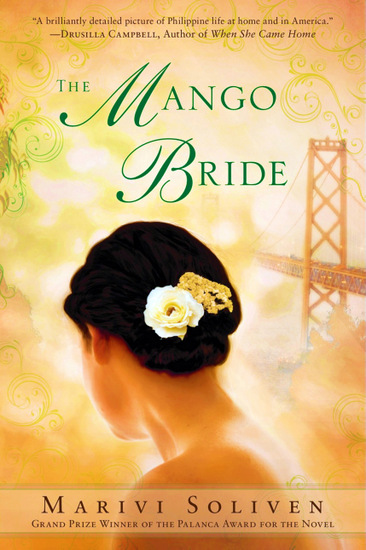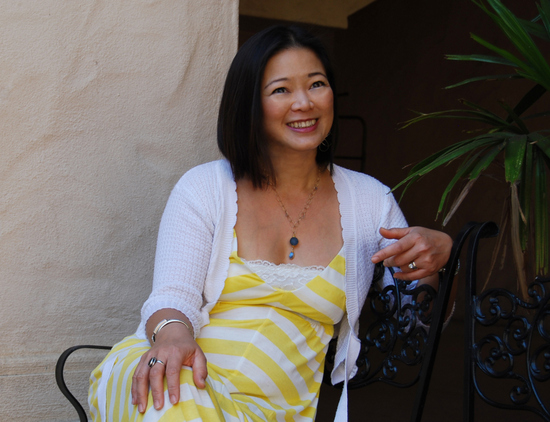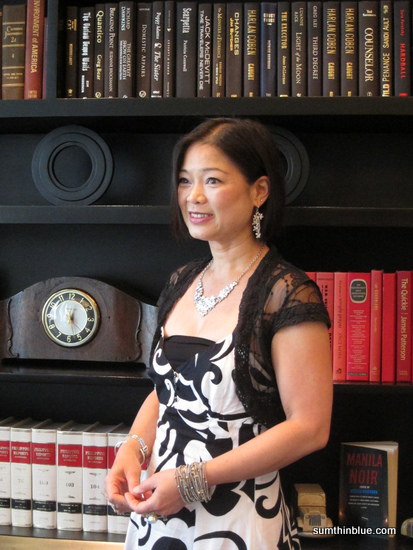I’ve always wanted to meet Marivi Soliven, because years and years ago (let’s not count anymore), I designed the cover of her book, “Spooky Mo,” an interesting collection of sinister short stories featuring the seven deadly sins and women who get their revenge on the men who provoke them. I remember how, when I got that particular manuscript from the publisher, I meant to pore over a few stories to get a feel of the text, and ended up reading the whole thing in one sitting!
Meeting Marivi was no doubt long overdue, and I was glad the opportunity presented itself with the launch of her novel, “The Mango Bride” last year at National Book Store.
Prior to its publication by NAL (New American Library) Accent this year, “The Mango Bride” won the Grand Prize for Novel in English at the 2011 Carlos Palanca Awards for literature. It portrays the story of two women, Amparo Guerrero and Beverly Obejas, who grew up with very different backgrounds in Manila before seeking new life in America.
 I must admit to having apprehensions when I first picked up a copy of “Mango Bride,” as my scant experience with immigrant novels (and what publishers often classify as “women’s literature,” for that matter) has not been very encouraging, and I often find them too weighed down with issues or agenda. “Mango Bride” proved to be a pleasant surprise.
I must admit to having apprehensions when I first picked up a copy of “Mango Bride,” as my scant experience with immigrant novels (and what publishers often classify as “women’s literature,” for that matter) has not been very encouraging, and I often find them too weighed down with issues or agenda. “Mango Bride” proved to be a pleasant surprise.
To Filipino readers, the stories of Amparo and Beverly may not be new, but I like the way “Mango Bride” tells it in a fresh manner. With a stabbing smack dab in the very first paragraph, it’s pretty hard not to get hooked on this novel. The prose is highly readable (belying the huge effort that went into crafting the words, I’m sure), and the depictions of the characters and situations in the novel were amazingly realistic. I mean, I realized, I knew both Amparo and Beverly, in a way I’m sure many Filipino readers will likewise recognize.
Amparo is the daughter of an illustrious de buena familia, while Beverly is a hopeful on the pen pal service Filipina Sweetheart (and I think that description will sufficiently clue you in on how they both end up in America). I truly enjoyed the way the characters were fleshed out, from their personalities, to their families, to the worlds they grew up in. I could distinctly feel the spectrum of emotions that both women experience throughout the novel — Amparo’s girlish excitement over that boy, Beverly’s determination for a better life, Amparo’s helplessness over being shipped out to the US, Beverly’s naivete over her fiancee, Amparo’s compassion for the callers she was assisting, and Beverly swallowing the bitter pill that her marriage had become — and this was mainly why I was so absorbed in the novel, I finished it in one sitting.
And while the novel does not make light of the situation the women face, the author keeps the focus on the storytelling, retaining the sincerity without falling into the conventional pitfalls of stories revolving around social issues.
***
Here’s the transcript of my very animated interview with Marivi at the Writer’s Bar at the Fairmont (wherein we found out we had so many connections between us!):
Q: How did this book come about?
A: Basically it started with this story. I was writing “Spooky Mo” in 2007, and I came across this one literary agent who was with the Sandra Dijkstra Agency, which is the one that handles Amy Tan of “The Joy Luck Club.” She read the manuscript of “Spooky Mo,” she really loved it and wanted to offer me literary representation. So she went back to her agency, and they said, “We don’t publish short story collections by unknown authors, unless they’ve been published in Granta or Atlantic, or other literary journals, does she have a novel?” At the time I didn’t have a novel and I realized, because I came so close to getting published in the States., that I need a novel talaga.
This was a real problem for me because I hadn’t written anything more than 10,000 words. And I had a real phobia of writing in the long form. What I did was, I joined NaNoWriMo in 2008, and it got me over that hump. Basically it’s a commitment to write a novel, 50,000 words in 30 days — it’s a marathon for writers. 1667 words a day, that’s three pages single-spaced, and I did it.
So I had a novel. It was not very good; I had the first line of it, I knew what the trajectory was going to be, but it was not worth publishing. So I went back to my friends in the San Diego writers (I was a board member at that time of San Diego writers), and Judy Reeves was at the time leading a writer’s reading critique group every Wednesday night, and she said, “Why don’t you join my group? Present a few pages, 10-15 pages every other Wednesday. Give it to us the Sunday before, we will read it, we will critique it, and that should help you get going.”
And so I joined, there were 8 of us, 4 of us were up every week. I wanted to take advantage, so I came up with a chapter every other week. That kept me going until December of 2010, when it was finally done. I went back to the agent and asked her to read it. But then, I had to give her a deadline because San Diego State University was sponsoring this writer’s conference and they were offering an early bird discount, so I told her that if she decided to pass on it, I would like to register early for three days of workshops and the chance to pitch my work to literary agents. My writing group laughed at me when they heard I gave the literary agent a deadline! I spent the rest of Christmas trying to figure out if I did something wrong, if she would read my novel.
January 2 comes and I wake up early, and at 9 in the morning, I got an email from the agent, and she said she loved the novel, but she wasn’t with the agency anymore and was currently handling foreign subsidiary rights. She says, “I really believe in this story, I love the characters, and I can’t help you, but with my peers in the industry, I think I can endorse you to other agents.”
So I decided to save my money and not go to conference, and within five minutes, I got an email from an agent, whose partner ended up taking the novel. Jill Marsal of the Marsal Lyon Literary Agency took it, and she had me revise certain things. By late February, we sent it out to the largest publishing houses. I got between 6 and 9 rejections, which were all kind of crushing, but at the end of March, Jill called me and she said, “Penguin wants to sign you,” and that was the beginning. I spent the next eight months for the editor to get through her other projects, and then we had a long conversation about the trajectory of the novel, and what could be revised. Her suggestions made sense, so I delivered the revised manuscript by August 2012, we went to copy editing, proofreading and galley until February 2013 until it was published in April.
Q. You certainly went a long way from the first manuscript, but what was your initial reaction when you finally got the offer from Penguin?
A: I was thrilled! I was over the moon. It’s like winning Miss Universe — you feel giddy; you’re laughing and crying… and in retrospect, I realized that it was a lot quicker than a lot of people. It was a much quicker process than many of my peers who have tried to get published. I’ve heard all kinds of horror stories. Like I have a friend who had to send out her manuscript and pitch letter to over 40 literary agents before one of them looked at it, another friend who already had a literary agent could not get his novel published at all so he started working on another novel. Those were just the people I knew. There were any number of people who toiled over novels for years and years, and then another few years to find an agent and even then the agent can’t get them published. In retrospect, the space of four months from my submission to an agent was like a nanosecond, and I was just incredibly lucky that it’s happened.
Q: What was the inspiration for this novel?
A. If you’ve read my book, “Suddenly Stateside,” that’s a collection of immigrant and autobiographical essays that have to do with what it was like to settle in the United States and become immersed in the culture even as you miss your home country. One of the essays, entitled, “A $3 Cebuana Fiancee,” was my first encounter with mail order brides. At the time I was in Berkeley, and I was breezing through this newspaper, and at the back page where they had all these classified ads, I chanced upon this website — I forgot what it’s called, something like Filipina Fiancee — and I wondered what it was about. I found that it was a matchmaking agency that had literally dozens or hundreds of pictures of these young-looking girls who were offering themselves up to be penpals with men who were looking for wives. I remember the phrase “Add to Cart” was part of the pitch; you click on a girl’s face, add to cart, and the more girls you picked, they cheaper each girl got. So by the time you had two dozen names picked, it came out to about $3 per girl. And I thought, ‘That’s cheaper than a six-pack!’ I actually went through the process of applying; I didn’t actually register but I saw this whole list of things you wanted your husband to be: occupation, age range, educational attainment, etc. Then I looked at the list of women and saw what their requirements were – political affiliation, not applicable; religious affiliation, not important — and this from a largely Catholic country; age range, 18-70. I thought, ‘Do they even know what they’re getting into?’
So I published that (story) and left it alone, and somewhere along the way, I took on a day job as an interpreter. I interpreted the court system for 911, for Social Services, etc. and one of the agencies I interpreted for was the National Domestic Violence Hotline. I noticed there was a disturbing increase in the number of calls I had to interpret for women who were being processed into shelters for abuse. I thought that was increasingly disturbing, even as the economy in the United States was getting bad, and finally a social worker told me that it’s a known fact that when the economy turns sour, domestic violence increases because the men look to vent their frustration on the nearest target, which is usually the wife. If the wife happens to be an immigrant who, for whatever reason, were refused to have their own job, then that woman is dependent on them because they hold her visa, her reason to being there. They can do whatever they want with her, and that is why a lot of women suffer in these abusive relationships.
When you’re newly married to an American, the INS gives you two years to stay together and a conditional green card. After two years, if you’re still married, they give you a permanent green card. The men know the women will put up with whatever they dish out for at least two years. If by then they’re still together and the woman is still alive, they will put up with it even longer for she’ll be there permanently. You know how it is here, if you come home na divorciada or separada, and what is there for you? These women have basically forsaken their country. They left in good faith and there is no exit for them unless the situation turns so awful that they have to flee.
When I noticed these women turning up in increasing numbers, and the calls were always so desperate, and heartbreaking, I thought their voices needed to be entered into the conversation of immigration, which was just then gaining momentum. Not that I wanted to come up with a message book; I just wanted to tell their story. It’s rife with dramatic tension, and it’s a story that needed to be brought up, and I just wanted to tell it.
Q. Have you gotten feedback from non-Filipino readers?
A. All along the route to writing the novel, I was in an all-Caucasian group that had never been to the Philippines, except for one guy who was in the Marines in Subic. They really enjoyed the parts about the Philippines, and they kept saying, ‘You need to slow down, to explain more about this. We really like the way you’re introducing this country.’ Because everyone knows Filipinos, but they don’t understand what Philippine culture is apart from lumpia and adobo. Filipinos don’t like to talk about their culture; for some reason it’s always just food. That’s ok too, but there are so many quirky things Filipinos can be proud about. There’s something about the Filipino sensibility that I find so charming and unique — we have a more accessible sense of humor than other cultures. There are so many things about the country that are never discussed, and so much more to be discussed.
Q. Has being a writer been a lifelong dream?
A. It’s one of those things I did all the time — I always wrote in diaries, I liked to read. I got into UP and Journalism was one of the few courses that had only one Math class. It was Martial Law, and there was a real fear among people in journalism, that death could be a huge occupational hazard. I knew that if I wanted to be a real journalist, I didn’t want to write fluff, but I kind of didn’t want to get killed. So I became a copywriter, because I could get paid a living wage for writing.
At a certain point, I got tired of having all my best ideas getting thrown out because they didn’t have enough product placement. So I wrote little stories with my friends’ names in them, and gave them as free and cheerful presents. After a while, Robert (Alejandro) who was my art director (I had already left advertising by then, he was searching for a way out as well) and he joined an illustrators’ workshop. He was looking for a story to illustrate, and since we had been a writer-art director team in the past, he asked, ‘Baka you have a story.’ This eventually became “The War of the Rose People,” and he loved it, and he made beautiful illustrations, and there was an exhibit. So I went to Bookmark and left a folder of my stories, and they wanted to publish my story, “The Unicorn.” Robert also illustrated that. It was an allegory for growing up, but since it was written in a narrative verse form, I got pegged as a children’s book writer. That was followed by “Chun,” which I wrote on a whim, which won the Palanca the year before it was published. That was followed by “The Toad and the Princess,” and “The War of the Rose People” and by then Reni Roxas (of Tahanan Books) contracted me to write the Jenny and Jay Private Eye series.
Q. Who are your literary influences?
A. Currently, Lysley Tenorio, Jhumpa Lahiri, Edwidge Danticat, M.F.K. Fisher, Edith Wharton. Just gorgeous, gorgeous writing. I just recently read East of Eden by John Steinbeck. I wouldn’t say he’s my favorite author; he’s a very, very dense writer, but you have to admire someone who writes something of that magnitude without a computer.
Transcribing this interview took a while because we just had so many things to talk about (some not printable here ^_^); it was definitely one of my more memorable author interviews! My mom has gone on to read “The Mango Bride” — she picked it off my shelf one day and I think she enjoyed it even more than I did, having spent a lot of time in the US and witnessing these kinds of stories for herself.
And seeing as a lot of my friends are doing NaNoWriMo (and/or dream of writing a novel), Marivi’s story is quite inspiring. You can read Marivi’s article 4 Ways to Grow A Newborn Novel over on the NaNoWriMo blog.
***
Mango Bride, trade paperback, 4/5 stars
Many thanks to National Book Store for the author interview






